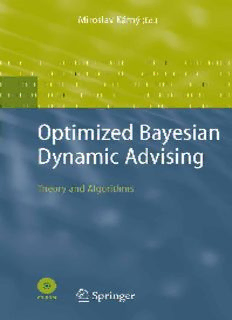
Optimized Bayesian Dynamic Advising: Theory and Algorithms (Advanced Information and Knowledge Processing) PDF
Preview Optimized Bayesian Dynamic Advising: Theory and Algorithms (Advanced Information and Knowledge Processing)
Advanced Information and Knowledge Processing Series Editors Professor Lakhmi Jain Xindong Wu Also in this series GregorisMentzas,DimitrisApostolou,AndreasAbeckerandRonYoung KnowledgeAssetManagement 1-85233-583-1 MichalisVazirgiannis,MariaHalkidiandDimitriosGunopulos UncertaintyHandlingandQualityAssessmentinDataMining 1-85233-655-2 Asuncio´nGo´mez-Pe´rez,MarianoFerna´ndez-Lo´pez,OscarCorcho OntologicalEngineering 1-85233-551-3 ArnoScharl(Ed.) EnvironmentalOnlineCommunication 1-85233-783-4 ShichaoZhang,ChengqiZhangandXindongWu KnowledgeDiscoveryinMultipleDatabases 1-85233-703-6 JasonT.L.Wang,MohammedJ.Zaki,HannuT.T.ToivonenandDennisShasha(Eds) DataMininginBioinformatics 1-85233-671-4 C.C.Ko,BenM.ChenandJianpingChen CreatingWeb-basedLaboratories 1-85233-837-7 ManuelGran˜a,RichardDuro,Aliciad’AnjouandPaulP.Wang(Eds) InformationProcessingwithEvolutionaryAlgorithms 1-85233-886-0 ColinFyfe HebbianLearningandNegativeFeedbackNetworks 1-85233-883-0 Yun-HehChen-BurgerandDaveRobertson AutomatingBusinessModelling 1-85233-835-0 DirkHusmeier,RichardDybowskiandStephenRoberts(Eds) ProbabilisticModelinginBioinformaticsandMedicalInformatics 1-85233-778-8 K.C.Tan,E.F.KhorandT.H.Lee MultiobjectiveEvolutionaryAlgorithmsandApplications 1-85233-836-9 AjithAbraham,LakhmiJainandRobertGoldberg(Eds) EvolutionaryMultiobjectiveOptimization 1-85233-787-7 Miroslav Ka´rny´ (Ed.) withJosefBo¨hm,TatianaV.Guy,LadislavJirsa,IvanNagy,PetrNedoma,Ludv´ıkTesaˇr Optimized Bayesian Dynamic Advising Theory and Algorithms Miroslav Ka´rny´, Ing DrSc DepartmentofAdaptiveSystems,InstituteofInformationTheoryandAutomation, Academy of Sciences of the Czech Republic, Prague, Czech Republic BritishLibraryCataloguinginPublicationData AcataloguerecordforthisbookisavailablefromtheBritishLibrary LibraryofCongressControlNumber:2005923319 Apartfromanyfairdealingforthepurposesofresearchorprivatestudy,orcriticismorreview,as permittedundertheCopyright,DesignsandPatentsAct1988,thispublicationmayonlyberepro- duced,storedortransmitted,inanyformorbyanymeans,withthepriorpermissioninwritingof thepublishers,orinthecaseofreprographicreproductioninaccordancewiththetermsoflicences issuedbytheCopyrightLicensingAgency.Enquiriesconcerningreproductionoutsidethoseterms shouldbesenttothepublishers. AI&KPISSN1610-3947 ISBN-10:1-85233-928-4 ISBN-13:978-1-85233-928-9 SpringerScience+BusinessMedia springeronline.com ©Springer-VerlagLondonLimited2006 Theuseofregisterednames,trademarks,etc.inthispublicationdoesnotimply,evenintheabsence of a specific statement, that such names are exempt from the relevant laws and regulations and thereforefreeforgeneraluse. Thepublishermakesnorepresentation,expressorimplied,withregardtotheaccuracyoftheinfor- mationcontainedinthisbookandcannotacceptanylegalresponsibilityorliabilityforanyerrors oromissionsthatmaybemade. Typesetting:Electronictextfilespreparedbyeditor PrintedintheUnitedStatesofAmerica (MVY) 34-543210 Printedonacid-freepaper Miroslav Ka´rny´, Josef B¨ohm, Tatiana V. Guy, Ladislav Jirsa, Ivan Nagy, Petr Nedoma, Ludv´ık Tesaˇr Optimized Bayesian Dynamic Advising SPIN Springer’s internal project number, if known Theory and Algorithms June 22, 2005 Springer Berlin Heidelberg NewYork HongKong London Milan Paris Tokyo This book compiles the results of three years of focused team work. Such a time span would be too short without a firm foundation. We therefore dedicate this text to V´aclav Peterka, Alena Halouskov´a and Rudolf Kulhav´y prominent representatives of the Department of Adaptive Systems, Institute of Information Theory and Automation, Academy of Sci- ences of the Czech Republic who helped both professionally and personally with the basis of the presented solution. Preface Thisworksummarizesthetheoreticalandalgorithmicbasisofoptimizedprob- abilistic advising.Itdevelopedfromaseriesoftargetedresearchprojectssup- ported both by the European Commission and Czech grant bodies. The source text has served as a common basis of communication for the research team. When accumulating and refining the material we found that the text could also serve as • a grand example of the strength of dynamic Bayesian decision making, • a practical demonstration that computational aspects do matter, • a reference to ready particular solutions in learning and optimization of decision-making strategies, • a source of open and challenging problems for postgraduate students, young as well as experienced researchers, • a departure point for a further systematic development of advanced opti- mized advisory systems, for instance, in multiple participant setting. These observations have inspired us to prepare this book. Prague, Czech Republic Miroslav Ka´rn´y October 2004 Josef Bo¨hm Tatiana V. Guy Ladislav Jirsa Ivan Nagy Petr Nedoma Ludv´ık Tesaˇr Contents 1 Introduction............................................... 1 1.1 Motivation ............................................. 1 1.2 State of the art ......................................... 3 1.2.1 Operator supports................................. 3 1.2.2 Mainstream multivariate techniques ................. 4 1.2.3 Probabilistic dynamic optimized decision-making ...... 6 1.3 Developed advising and its role in computer support ......... 6 1.4 Presentation style, readership and layout ................... 7 1.5 Acknowledgements ...................................... 10 2 Underlying theory ......................................... 11 2.1 General conventions ..................................... 11 2.2 Basic notions and notations............................... 12 2.3 Decision making under uncertainty ........................ 16 2.3.1 Complete ordering of decision rules .................. 17 2.3.2 Calculus with pdfs................................. 21 2.3.3 Basic decision-making lemma ....................... 24 2.4 Dynamic design ......................................... 25 2.4.1 Dynamic programming............................. 25 2.4.2 Fully probabilistic design ........................... 28 2.4.3 Asymptotic of the design ........................... 31 2.5 Learning ............................................... 33 2.5.1 Bayesian filtration................................. 33 2.5.2 Bayesian estimation ............................... 36 2.5.3 Asymptotic of estimation........................... 38 3 Approximate and feasible learning......................... 43 3.1 Estimation with forgetting................................ 44 3.2 Exponential family ...................................... 47 3.3 Structure estimation in the nested exponential family ........ 49 3.4 Equivalence approach .................................... 50 X Contents 3.4.1 Recursively feasible representation................... 51 3.4.2 Approximation as a point estimation................. 53 3.4.3 Specification of E[f (Ψ)|g ].......................... 54 t t 4 Approximate design ....................................... 57 4.1 Adaptive systems........................................ 57 4.2 Suboptimal design....................................... 58 4.2.1 Strategies examining reduced space .................. 58 4.2.2 Strategies simplifying models ....................... 60 4.3 Decomposition of decision-making ......................... 62 4.3.1 Offline phase...................................... 63 4.3.2 Online phase...................................... 65 5 Problem formulation....................................... 67 5.1 Design principle and design conditions ..................... 67 5.1.1 Systems and data spaces ........................... 68 5.1.2 Basic scenario and design principle .................. 69 5.1.3 Reduction of surplus data of the operator ............ 71 5.1.4 Construction of a true user’s ideal pdf ............... 72 5.1.5 Extension of a true user’s ideal pdf to the surplus p-data................................. 73 5.2 Learning conditions...................................... 74 5.3 Mixtures as approximate models and predictors ............. 79 5.4 Design of advisory systems ............................... 82 5.4.1 Types of advisory systems .......................... 82 5.4.2 Advices as actions of the p-system................... 83 5.4.3 Unguided and guided models for respective designs .... 84 5.4.4 Academic design .................................. 85 5.4.5 Industrial design .................................. 87 5.4.6 Simultaneous academic and industrial design.......... 88 5.5 Interactions with the operator............................. 89 5.5.1 Assigning priorities ................................ 89 5.5.2 Stimulating the operator ........................... 91 5.6 Design summary ........................................ 92 5.6.1 Influence of advices on the o-system ................. 92 5.6.2 Overall scenario and design subtasks................. 93 6 Solution and principles of its approximation: learning part. 95 6.1 Common tools .......................................... 96 6.1.1 Prediction and model selection ...................... 97 6.1.2 Likelihood on variants ............................. 98 6.1.3 Branch-and-bound techniques.......................100 6.2 Data preprocessing ......................................102 6.2.1 Data transformation ...............................103 6.2.2 Outlier removal ...................................104
Description: